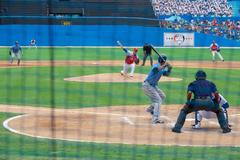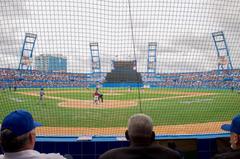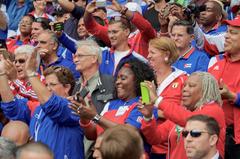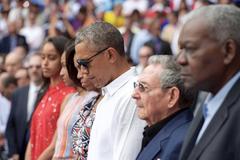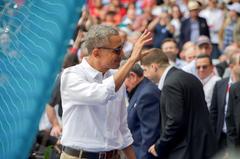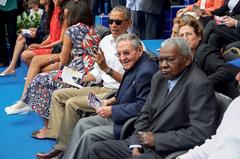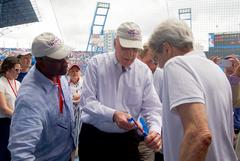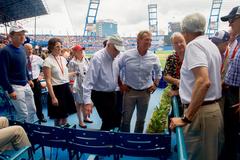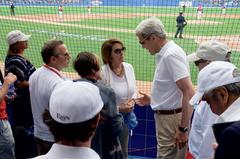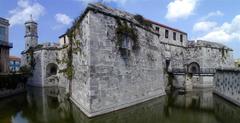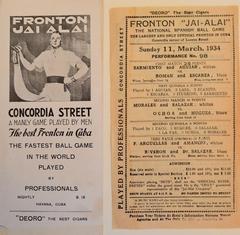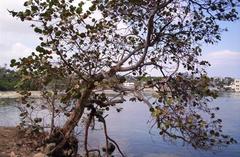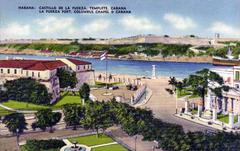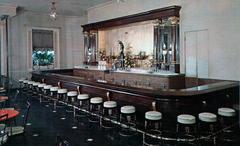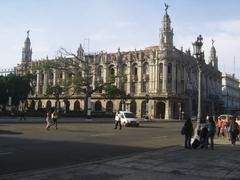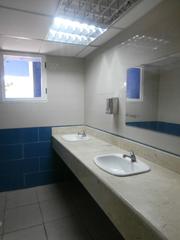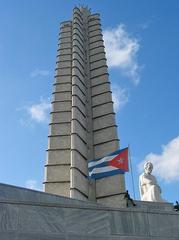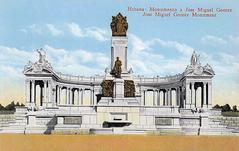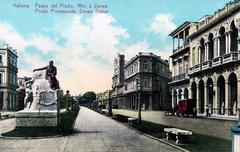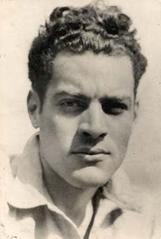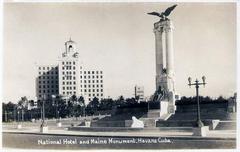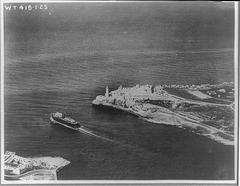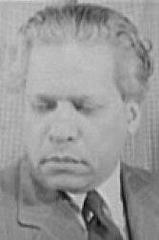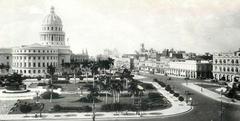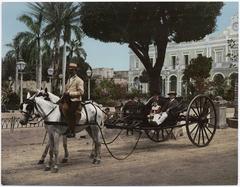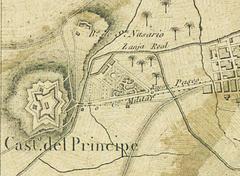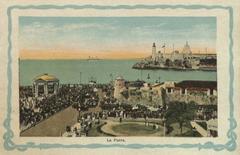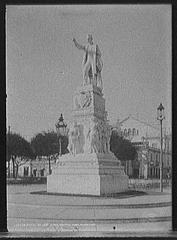
Estadio Latinoamericano Visiting Hours, Tickets, and Havana Historical Sites Guide
Date: 14/06/2025
Introduction: The Heart of Havana’s Baseball and Heritage
Estadio Latinoamericano, affectionately called “El Coloso del Cerro,” stands as a monumental symbol of Cuban culture, sports, and history. Since its inauguration in 1946, it has been the beating heart of Cuban baseball, a stage for historic events, and a reflection of the nation’s evolving identity. With a seating capacity of approximately 55,000, it is not only the largest baseball stadium in Cuba but also a vibrant gathering place for locals and visitors. Its architectural grandeur, central location in Havana’s Cerro district, and role in pivotal moments of Cuban history make it a must-visit among Havana historical sites.
This guide provides everything you need to know about visiting Estadio Latinoamericano—covering its history, cultural significance, visiting hours, ticketing, facilities, accessibility, nearby attractions, travel tips, and answers to frequently asked questions. Whether you’re a baseball fan or a traveler exploring Havana’s rich heritage, this article will help you plan an unforgettable visit.
Table of Contents
- Introduction
- Historical Overview
- Visiting Estadio Latinoamericano
- Game Day Experience
- Nearby Attractions
- Special Events & Tours
- Frequently Asked Questions (FAQ)
- Visuals and Media
- Conclusion & Call to Action
- References
1. Historical Overview
Origins and Construction
Built between 1945 and 1946 by visionary baseball executive Bobby Maduro, the stadium was originally named Gran Estadio de La Habana. Its first game, held on October 26, 1946, drew more than 30,000 fans who watched Almendares and Cienfuegos compete. The site quickly gained renown as the main venue for the Cuban Winter League, hosting legendary teams and international tournaments (cubadugout.com).
Evolution and Cultural Significance
Following the Cuban Revolution in 1959, professional sports were replaced by an amateur system. The stadium was renamed Estadio Latinoamericano in 1961, highlighting its symbolic role in uniting Latin American culture through baseball. It became the home field for Havana’s beloved Industriales and the centerpiece of the Cuban National Series (Cuba.com).
Architecturally, Estadio Latinoamericano is celebrated for its modernist design, with sweeping concrete arches and double-deck grandstands. Its blue color scheme and murals make it a visual icon in Havana (oldstadiumjourney.com). The stadium underwent significant expansion in 1971, increasing its capacity to 55,000 and reaffirming its status as a major Latin American sports venue (es.wikipedia.org).
Modern Era and International Events
The stadium has hosted key moments in Cuban and international sports, including the Caribbean Series, Pan-American Games, and historic matches such as the 2016 exhibition between the Tampa Bay Rays and the Cuban national team, attended by Presidents Barack Obama and Raúl Castro (Ultimate Travel Advice).
In 2014, Estadio Latinoamericano was the site of the revival of the Cuban Baseball Hall of Fame, bridging the pre- and post-revolutionary eras of Cuban baseball (VICE).
2. Visiting Estadio Latinoamericano
Location & Getting There
Estadio Latinoamericano is located in the Cerro neighborhood of Havana, at Avenida Cerro y Calle Patria. Its central setting makes it easily accessible from Old Havana and Vedado.
- Taxi: Widely available, with fares from Old Havana ranging from 10–20 USD.
- Public Bus: Routes P12, P16, and 27 serve the area. Fares are very low but buses can be crowded.
- Classic Car: For a unique Cuban experience, classic cars can be hired through hotels or tour operators.
Arriving early is recommended, especially on game days, as parking fills quickly.
Visiting Hours
- Game Days: The stadium opens approximately two hours before the first pitch. The Cuban National Series typically runs from August to January, with playoffs extending into February.
- Non-Game Days: Access for guided tours or special events is possible but should be arranged in advance through official channels or local tour operators (Havana Tourism Official Site).
Ticket Information
- Purchasing: Tickets are available at the stadium box office on game days and through authorized vendors. For special events, tickets may also be purchased online or via travel agencies.
- Pricing: Local game tickets are very affordable (5–20 CUP for residents, higher for tourists and premium events).
- Tips: Buy tickets in advance for popular games. Bring a valid photo ID for entry.
Accessibility
- Facilities: The stadium offers ramps and some designated seating for visitors with disabilities, though not all standards may match international ADA guidelines. It is advisable to make arrangements ahead of time for accessible seating.
Facilities & Amenities
- Seating: Mix of covered and uncovered sections, with the best views behind home plate.
- Restrooms: Available, though basic by international standards—bring tissues or sanitizer.
- Food & Drink: Concession stands serve local snacks and beverages at low prices.
- Souvenirs: Team merchandise and memorabilia are available at kiosks.
- Wi-Fi: Limited; consider a local SIM or Wi-Fi card.
Travel Tips
- Bring local currency (CUP) for purchases, as credit cards have limited acceptance.
- Dress comfortably and use sun protection, as much seating is open-air.
- Stay hydrated and opt for bottled water.
3. Game Day Experience
Attending a game at Estadio Latinoamericano is an immersion in Cuban culture. The stands are alive with chants, music, and the rhythmic enthusiasm of fans supporting the Industriales or visiting teams. Vendors circulate with roasted peanuts, churros, and refreshing drinks. The sense of community is palpable, and visitors are welcomed to join in the festivities (Cuba.com).
Photography is allowed for personal use—capture the excitement, but be respectful of other spectators.
4. Nearby Attractions
The stadium’s proximity to central Havana offers visitors a wealth of attractions:
- Old Havana: UNESCO World Heritage Site with plazas, colonial architecture, museums, and vibrant street life.
- Malecón: Havana’s famous seaside boulevard, ideal for a stroll after the game.
- Plaza de la Revolución: Iconic political square, just 2 km away.
- Local Eateries: Sample authentic Cuban cuisine at paladares and street food stalls.
ATMs, banks, and currency exchange offices are available in central Havana.
5. Special Events & Tours
Estadio Latinoamericano occasionally hosts guided tours, offering insights into its history, architecture, and role in Cuban baseball. During international events like the MLB World Tour, interactive fan zones, batting cages, and cultural exhibitions provide extra excitement (MLB World Tour 2026).
Tours should be booked in advance through local agencies or the stadium’s official website.
6. Frequently Asked Questions (FAQ)
Q: What are the stadium’s visiting hours?
A: Open primarily on game days, with box office and gates opening 1–2 hours before the match. For tours or special events, check the official schedule.
Q: How do I purchase tickets?
A: At the stadium box office, through authorized vendors, or online for major events.
Q: Is the stadium accessible for visitors with disabilities?
A: There are ramps and some accessible seating, but facilities are limited—contact the stadium in advance for assistance.
Q: Are cameras allowed?
A: Personal cameras and smartphones are permitted; professional equipment requires prior approval.
Q: What attractions are nearby?
A: Old Havana, Malecón, Plaza de la Revolución, and local dining options.
7. Visuals and Media
-
Panoramic image: Estadio Latinoamericano with its iconic arches and double-deck grandstand.
Alt text: “Estadio Latinoamericano Havana exterior with concrete arches and seating.” -
Interior photo: Game in progress, fans cheering in vibrant blue stands.
Alt text: “Baseball game in progress at Estadio Latinoamericano, Havana.” -
Short video: Showcasing the stadium architecture and game day atmosphere.
Alt text: “Video tour of Estadio Latinoamericano in Havana.”
For virtual tours and more images, visit the Official Estadio Latinoamericano Website.
8. Conclusion & Call to Action
Estadio Latinoamericano is more than a sports venue—it is a living monument to Cuba’s enduring love for baseball, its rich architectural heritage, and its vibrant community spirit. From the thrill of local games to the significance of international events, visiting the stadium offers a unique window into Cuban culture and history.
Plan ahead:
- Check official schedules and buy tickets in advance.
- Explore nearby Havana attractions and savor local cuisine.
- Download the Audiala app for real-time updates, travel guides, and exclusive insights.
Share your experience:
Connect with fellow enthusiasts and share your photos with #ElColosoDelCerro. For ongoing updates, follow the stadium and tourism boards on social media.
9. References
- Estadio Latinoamericano: A Complete Visitor’s Guide to Havana’s Historic Baseball Stadium (2025) (http://www.estadiolatinoamericano.cu)
- Estadio Latinoamericano Visiting Hours, Tickets, and Architectural Highlights in Havana (2025) (https://cubadugout.com/2021/04/27/estadio-latinoamericano-havana-through-my-lens/)
- Estadio Latinoamericano Havana: Visiting Hours, Tickets & Cultural Significance of Cuba’s Iconic Baseball Stadium (2025) (https://ultimatetraveladvice.com/articles/destinations/22-international-baseball-stadiums-that-rival-the-best-in-america/)
- Estadio Latinoamericano Visiting Hours, Tickets & Guide to Havana’s Historic Baseball Stadium (2025) (https://www.cubatravel.cu/en/)
- Havana Tourism Official Site (2025) (https://www.havanatourism.com)
- Cuba.com Sports Section (2025) (https://cuba.com/sports)
- VICE Article on Cuban Baseball Hall of Fame Revival (2025) (https://www.vice.com/en/article/the-cuba-diaries-how-a-dead-hall-of-fame-was-brought-back-to-life/)
- Tourist Secrets Guide to Estadio Latinoamericano (2025) (https://www.touristsecrets.com/travel-guide/adventure/the-home-plate-view-of-estadio-latinoamericano/)
- Adequate Travel Guide to Estadio Latinoamericano (2025) (https://www.adequatetravel.com/placeguide/Cuba/estadio-latinoamericano-havana-in-cuba-overview-prominent-features-history-interesting-facts)
- MLB World Tour 2026 Event Details (2025) (https://tour2026.com/mlb-world-tour-2026-a-grand-slam-of-global-baseball-excitement/)
